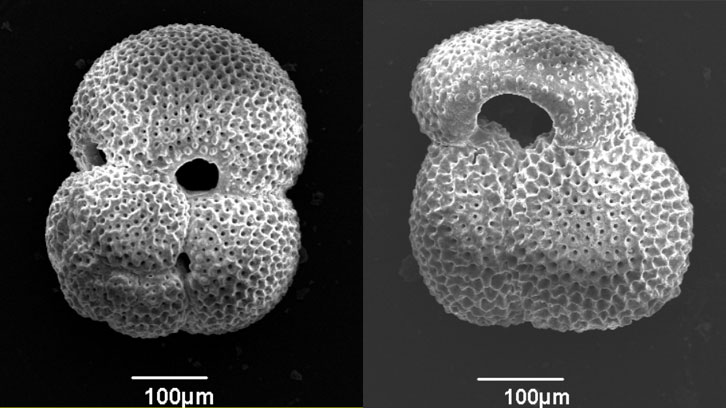Differences in zooplankton forms in the Gulf of Mexico during the last deglaciation

As earth scientists, oceanographers, and global change scientists, one of our central missions is to better understand the meaning of “natural” variability, so as to more accurately discern those that are anthropogenic (human-induced). The last glacial maximum (LGM, ~ 20ka) and subsequent deglaciation (Termination 1, T1) presents a geologically recent backdrop of pronounced natural and global warming, and hence an ideal “testbed” for such studies.
In our recent paper published in GCA (link), we employed a variety of geochemical proxies preserved in the fossilized carbonate shells of planktonic foraminifera (zooplankton, figure), from high sedimentation rate sequences from the Gulf of Mexico, an ideal setting in which to document the relatively rapid meltwater inputs from the Laurentide Ice Sheet (LIS) via the Mississippi River drainage system.
The proxies trace the sea surface temperature, salinity, and productivity (and more generally speaking “hydrography”) history by exploiting the 2 major morphotypes of a surface dwelling species (Globigerinoides ruber), and their slight but important differences in depth habitat preference.
Our collective results point to the hydrographic adjustments that occurred during T1 as a result of meltwater variability, and hence how LIS decay dynamics impacted an important surface ocean region, which then globally led to a greater climate change than that occurring in the Atlantic (via the Gulf Stream current, N. Atlantic Deep Water convective overturning, and more).
While our conclusions are enticing, as with any thoroughly conducted scientific research effort we remain with as many or more questions as answers. Continuing and future research efforts with similar (and different) proxy systems applied to the recent past and additional aspects of T1 will certainly intrigue us further on how the Earth undergoes “global warming”, and just what this means for how we humans might be modifying these processes.
References
Antonarakoua, A.; Kontakiotisa, G.; Mortynb, P.G.; Driniaa, H.; Sprovierid, M.; Besioua, E.; Tripsanase, E. Biotic and geochemical (δ18O, δ13C, Mg/Ca, Ba/Ca) responses of Globigerinoides ruber morphotypes to upper water column variations during the last deglaciation, Gulf of Mexico. Geochimica et Cosmochimica Acta. 2015, vol. 170, p. 69-93. doi: 10.1016/j.gca.2015.08.003.


